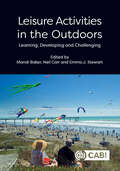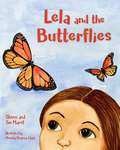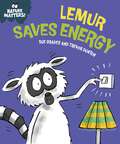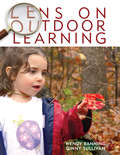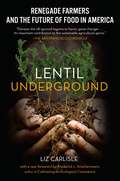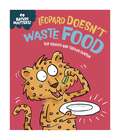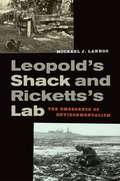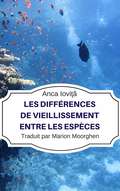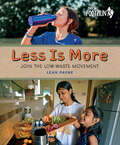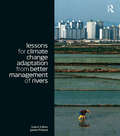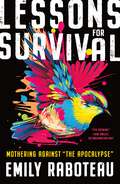- Table View
- List View
Leif and the Fall
by Adam Grant Allison Sweet GrantPersistence and creativity can lead to amazing things, as Leif the leaf discovers in this lovely storybook from Allison Sweet Grant and Adam Grant, the #1 New York Times bestselling author of Originals.Leif is a leaf. A worried leaf. It is autumn, and Leif is afraid to fall. "All leaves fall in the fall," say the other leaves. But Leif is determined to find a different way down, and with his friend Laurel, he uses the resources around him to create a net, a kite, a parachute in hopes of softening his landing. The clock is ticking, the wind is blowing. What will happen when a gust of wind pulls Leif from his branch?In a culture that prizes achievement, kids are often afraid to fail--failing to realize that some of the very ideas that don't work are steps along the path to ones that will.
Leisure Activities in the Outdoors: Learning, Developing and Challenging
by Mandi Baker, Neil Carr, Emma J. StewartThe benefits of being outdoors in a leisure context are widely acknowledged across a range of disciplinary perspectives (including tourism, therapeutics, education and recreation). These benefits include the development of: health and wellbeing; social skills; leadership and facilitation skills; personal, emotional and reflective abilities; confidence and identity creation. Drawing on a variety of perspectives, geographies and approaches, this book explores the opportunities that leisure in the outdoors provides for learning, developing and challenging. The authors in this collection challenge dominant discourses of outdoor leisure through their selection of outdoor activities, theoretical approaches and modes of representation. All offer fresh insights and thinking into how leisure in the outdoors can be understood. The book covers a range of outdoor conceptualisations that challenge the reader to think deeply and broadly about the common threads which bind the broad field of outdoor leisure together. The experiences explored in this book range from suburban outdoors to wild places, surfing to mindful reflection, and trail walking to Nordic skiing, and encompass a broad spectrum of people. This book will appeal to outdoor scholars from a variety of contexts, including recreation, tourism, and adventure. It provides: ·original and leading research across layers of meaning attributed to and drawn from leisure experiences in the outdoors; ·value in theorising the notions of outdoor experiences; ·a variety and scope of contexts and approaches for students to draw on when learning about the field of outdoor leisure.
Leitungsgebundene Energieversorgung in Mittel- und Osteuropa: Elektrizität, Erdgas und Fernwärme
by Andrea Simon Tino Schütte Emil Dvorský Olga Borozdina Arvydas Galinis Géza Mészáros Vaclovas Miškinis Edyta Ropuszyńska-Surma Gunta Šlihta Kaspars Šlihta Kvetoslava Šoltésová Jaroslav Šoltés Zdzisław Szalbierz Magdalena Węglarz Lenka Raková Martin SirovýEine funktionierende leitungsgebundene Energieversorgung ist Voraussetzung für die industrielle Entwicklung eines Landes. Das Buch gibt einen fundierten Überblick über die Strom-, Gas- und Fernwärmeversorgungssysteme in den Ländern der Visegrad-Gruppe, des Baltikums sowie Russlands, Belarus und der Ukraine. Gleichzeitig werden Ansatzpunkte zur Modernisierung der Energienetze offengelegt. Nationale Besonderheiten und Entwicklungsstände werden aufgezeigt. Durch die abgestimmte Struktur der Beiträge ist ein Vergleich der Systeme möglich. Die Länderberichte sind von ausgewiesenen Fachleuten der betreffenden Staaten verfasst. Sie spiegeln die seit 25 Jahren bestehende Zusammenarbeit im Rahmen des Zittauer Energieseminars zur energiewirtschaftlichen Situation in Mittel- und Osteuropa wider. Jeder Beitrag beinhaltet eine technisch-ökonomische Sachstandsanalyse und geht auf Entwicklungsperspektiven ein. Das Werk zeigt Verbesserungspotentiale bzgl. Infrastrukturausbau und Energieeffizienz auf.
Lela and the Butterflies
by Sherri Maret Tim MaretLela loves butterflies. When Lela takes a nature walk with Ranger Maggie, she learns that butterflies need help. Lela's small steps in butterfly conservation start with a butterfly garden of nectar and host plants, but she doesn't stop there and ends up spreading her love for butterflies throughout the community. A simple guide to planting a butterfly garden is also included.
Lemur Saves Energy (Nature Matters)
by Sue GravesLemur Saves Energy offers a gentle introduction to the concept of using energy carefully for young children.In this humorous story, Lemur is always wasting energy. He forgets to switch off the light, he lets all the hot air out of the front door and all the cold air out of the fridge. But when a big energy bill arrives, Lemur wants to make a change!This charming book is the perfect way to introduce young children to the concept of conserving energy. Also included are suggestions for activities and ideas to talk through together to help children understand the concept.The Nature Matters series of picture books provide a gentle means of promoting concepts of environmental issues, boosting self-esteem and reinforcing good behaviour. Supports the Personal, Social and Emotional Development Area of Learning in the Early Years Foundation Stage, and is also suitable for use with children in KS1 and can be used to discuss citizenship and values. Suitable for children aged 3+.
Lemurs (Animals)
by Jaclyn JaycoxLemurs are small, furry mammals with big eyes and long tails. Like humans, they are primates. These adorable animals settle their arguments with stink fights! Find out more about these curious creatures.
Lens on Outdoor Learning
by Wendy Banning Ginny SullivanThe outdoors is full of rich learning experiences for preschool and pre-kindergarten children. Lens on Outdoor Learning is filled with stories and colorful photographs that illustrate how the outdoors supports children's early learning. Each story is connected to an early learning standard such as curiosity and initiative; engagement and persistence; imagination, invention, and creativity; reasoning and problem-solving; risk-taking, responsibility, and confidence; reflection, application, and interpretation; and flexibility and resilience. Much of the teaching in these experiences is indirect and involves provisioning, observing, and conversing with children as they spend quality time in nature. Children's dialogue and actions are included in each story to show just how engaged they became during these experiences. Lens on Outdoor Learning will inspire early childhood professionals to use this outdoor approach in their own setting.Wendy Banning is coordinator of Irvin Learning Farm, an inquiry-based, hands-on outdoor learning space for children and adults in North Carolina. She is also an educational consultant, teacher, trainer, and photographer.Ginny Sullivan is co-principal of Learning by the Yard, a partnership of landscape architects and educators that helps schools develop their grounds as habitat, focusing on native plants. Ginny consults, trains teachers, and involves schools and centers in the design of their outdoor spaces to help children learn about the natural world.
Lentil Underground: Renegade Farmers and the Future of Food in America
by Liz CarlisleA protégé of Michael Pollan shares the story of a little known group of renegade farmers who defied corporate agribusiness by launching a unique sustainable farm-to-table food movement.<P><P> The story of the Lentil Underground begins on a 280-acre homestead rooted in America's Great Plains: the Oien family farm. Forty years ago, corporate agribusiness told small farmers like the Oiens to "get big or get out." But twenty-seven-year-old David Oien decided to take a stand, becoming the first in his conservative Montana county to plant a radically different crop: organic lentils. <P> Unlike the chemically dependent grains American farmers had been told to grow, lentils make their own fertilizer and tolerate variable climate conditions, so their farmers aren't beholden to industrial methods. Today, Oien leads an underground network of organic farmers who work with heirloom seeds and biologically diverse farm systems. Under the brand Timeless Natural Food, their unique business-cum-movement has grown into a million dollar enterprise that sells to Whole Foods, hundreds of independent natural foods stores, and a host of renowned restaurants.<P> From the heart of Big Sky Country comes this inspiring story of a handful of colorful pioneers who have successfully bucked the chemically-based food chain and the entrenched power of agribusiness's one percent, by stubbornly banding together. Journalist and native Montanan Liz Carlisle weaves an eye-opening and richly reported narrative that will be welcomed by everyone concerned with the future of American agriculture and natural food in an increasingly uncertain world.
Leon and the Champion Chip
by Allen KurzweilLeon's back. Having survived the sweatshop methods of Miss Hagmeyer, his needle-wielding fourth grade teacher at the Classical School, Leon braces himself for fifth grade. He arrives armed with a backpack full of pens and pencils, binders and notebooks . . . plus a rag doll that's the spitting image of Henry Lumpkin, the bully who has Leon in his sights. If the doll works the way it's supposed to, Leon (and his buddies P.W. and Lily-Matisse) won't have to worry about Lumpkin the Pumpkin! Better still, Leon has a fabulous new teacher, Mr. Sparks, who conducts science experiments using that most miraculous of research materials -- the potato chip. And a good thing, too. Mr. Sparks's lab work will come in handy when Leon is forced to take on Alphonse "The Chippopotamus" Cipollini at the annual Chipapalooza! Chip-Off. Once you've sunk your teeth into Leon and the Champion Chip, the hilarious sequel to Leon and the Spitting Image, you'll never eat potato chips the same way again!
Leopard Doesn't Waste Food (Nature Matters)
by Sue GravesLeopard Doesn't Waste Food offers a gentle introduction to the concept of not wasting food for young children.In this humorous story, Leopard often throws away food. He sometimes takes too much, or he doesn't store it carefully and then doesn't want to eat it. But after a day on the farm and Wolf's party, he wants to make a change!This charming book is the perfect way to introduce young children to the concept of food waste. Also included are suggestions for activities and ideas to talk through together to help children understand the concept.The Nature Matters series of picture books provide a gentle means of promoting concepts of environmental issues, boosting self-esteem and reinforcing good behaviour. Supports the Personal, Social and Emotional Development Area of Learning in the Early Years Foundation Stage, and is also suitable for use with children in KS1 and can be used to discuss citizenship and values. Suitable for children aged 3+.
Leopards (Nature's Children)
by Jen GreenWhere do leopards live? How fast can a leopard run? What colors are leopards? Can leopards purr? Find out the answers to these questions and much more about leopards!
Leopold’s Shack and Ricketts’s Lab: The Emergence of Environmentalism
by Michael J. LannooAldo Leopold and Ed Ricketts are giants in the history of environmental awareness. This illuminating book reveals the full extent of their profound and parallel influence both on science and our perception of natural world today.
Leopold’s Shack and Ricketts’s Lab: The Emergence of Environmentalism
by Michael LannooAldo Leopold and Ed Ricketts are giants in the history of environmental awareness. They were born ten years and only about 200 miles apart and died within weeks of each other in 1948. Yet they never met and they didn't read each other's work. This illuminating book reveals the full extent of their profound and parallel influence both on science and our perception of natural world today. In a lively comparison, Michael J. Lannoo shows how deeply these two ecological luminaries influenced the emergence both of environmentalism and conservation biology. In particular, he looks closely at how they each derived their ideas about the possible future of humanity based on their understanding of natural communities. Leopold and Ricketts both believed that humans cannot place themselves above earth's ecosystems and continue to survive. In light of climate change, invasive species, and collapsing ecosystems, their most important shared idea emerges as a powerful key to the future.
Lernziele und Kompetenzen im Bereich Nachhaltigkeit (Theorie und Praxis der Nachhaltigkeit)
by Walter Leal FilhoDas Buch zeigt Ihnen, wie sich Lernziele und Kompetenzen im Bereich Nachhaltigkeit ergänzen und hilft, die komplexe und vernetzte Natur der Nachhaltigkeit besser zu verstehen, und die damit verbundenen Herausforderungen zu erkennen und anzugehen. Dazu gehört auch die Vermittlung von Kenntnissen über die verschiedenen Aspekte der Nachhaltigkeit, wie z. B. ökologische, soziale und wirtschaftliche Aspekte, sowie deren Wechselwirkung miteinander. Darüber hinaus zeigt das Buch auf, wie Sie die möglichen Auswirkungen von Entscheidungen und Maßnahmen auf die Nachhaltigkeit einschätzen und bewerten können. Das Buch beschreibt die Zusammenhänge zwischen Nachhaltigkeit und Lernen. Es wird erörtert, wie Bildung und Lernen im Bereich der Nachhaltigkeit uns helfen können, die natürliche Welt und unsere Beziehung zu ihr zu verstehen und bessere Entscheidungen zu treffen, um unser Leben und die Umwelt zu verbessern. Es untersucht auch die Rolle von Technologie und Bildung im Bereich der Nachhaltigkeit und erkundet, wie Nachhaltigkeit in den Unterricht und das Lernen integriert werden kann. Schließlich enthält das Buch praktische Ratschläge zur Schaffung eines nachhaltigen Lernumfelds und zur Anwendung von Nachhaltigkeit in der Hochschulbildung und in den unteren Bildungsstufen.
Les Profondeurs
by Nick Thacker Guillaume Tougeron"Allo ?" La voix de Jen était trouble et confuse. Qui pouvait bien l'appeler à cette heure tardive ? Il était dix heures passé un mercredi soir, et selon son habitude, elle aurait dû être en train de boire un verre de vin avant d'aller se coucher. Aucune réponse. Elle parla à nouveau au téléphone, mais plus fort et sur un ton plus direct. "Allo ?" Elle entendit un bruissement au bout du fil, comme de l'hésitation, suivit d'un bruit de respiration. Mais aucun mot ne fut prononcé. Elle fronça les sourcils, écarta le téléphone de son oreille et appuya sur la touche Fin. Le numéro clignota une fois de plus, un numéro inconnu, puis laissa place à l'écran d'accueil.
Les différences de vieillissement entre les espèces
by Anca IoviţăLe vieillissement est une énigme à résoudre. Ce processus est traditionnellement étudié sur des modèles biologiques tels que les mouches drosophiles, les vers et les souris. Le point commun de toutes ces espèces est leur vieillissement rapide. Elles sont donc parfaitement adaptées aux budgets serrés alloués aux études en laboratoire. C’est également une excellente stratégie à court terme ; après tout, qui a le temps d’étudier des espèces qui vivent plusieurs décennies ? Mais les différences de durée de vie entre les espèces sont bien plus importantes que celles que l’on peut observer en laboratoire. C’est d’ailleurs ce qui m’a poussée à faire des recherches approfondies et à rassembler des études hautement spécialisées dans un livre à la portée de tous. Je voulais trouver la forêt parmi les arbres. Je voulais expliquer les différences de vieillissement entre les espèces de façon logique et facile à comprendre. J’ai écrit cet ouvrage avec cela pour unique but. Quels sont les mécanismes à la base des différences de vieillissement entre les espèces ? J’ai intentionnellement choisi de répondre à cette question dans un langage accessible à tous. La recherche sur le vieillissement est bien trop importante pour être occultée par un jargon scientifique formel. Cet ouvrage n’aurait pas vu le jour sans l’existence du thé vert, des bibliothèques et d’Internet. Le volume de données que j’ai dû éplucher pour répondre à cette question est énorme. Pourtant cet ouvrage n’est pas exhaustif. Il ne s’agit pas d’un manuel académique ennuyeux. J’ai essayé de rendre vivant un sujet qui est d’importance capitale pour l’extension de la durée de vie des êtres humains. Et vous seuls pourrez me dire si j’y suis parvenue. ********** Contents ************** Trouver la forêt parmi les arbres Mieux vaut être fiable Les mathématiques du vieilli
Lesotho Highlands Water Project: Communication Practices for Governance and Sustainability Improvement
by Leonardo Mazzei Lawrence J. M. Haas Donal O'LearyThis paper considers the multi-faceted lessons of the Lesotho Highlands Water Project and how the project can serve as a model of mutually beneficial development, though demonstrating the benefits of a bilateral governmental cooperative approach in the development of an international river. These benefits include exceeding the impact of individual national approaches and strengthening political cooperation among all participants. This model is particularly relevant since approximately 40 percent of the world's population lives in transboundary river basins and more than 90 percent of the world's population lives within countries that share these basins.
Less Heat, More Light: A Guided Tour of Weather, Climate, and Climate Change
by John D. AberA straightforward and fact-based exploration of how weather happens, how it relates to climate, and how science answers major questions about Earth as a system Climate change is one of the most hotly contested environmental topics of our day. To answer criticisms and synthesize available information, scientists have been driven to devise increasingly complex models of the climate system. This book conveys that the basics of climate and climate change have been known for decades, and that relatively simple descriptions can capture the major features of the climate system and help the general public understand what controls climate and weather, and how both might be changing. Renowned environmental scientist and educator John D. Aber distills what he has learned from a long fascination with weather and climate, the process of science, and the telling of the story of science. This is not a book about policies and politics. Instead, it explores how weather happens, how it relates to climate, and how science has been used to answer major questions about the Earth as a system and inform policies that have reversed environmental degradation. By providing a guided tour of the science of weather, this thoughtful survey will contribute clarity and rationality to the public understanding of climate change.
Less Is More: Join the Low-Waste Movement (Orca Footprints #28)
by Leah PayneAll over the world, people are joining the low-waste movement and getting tough on their trash. Maybe you’ve heard the reports of the Great Pacific Garbage Patch swirling in the ocean. Maybe you’ve seen the photos of whales and sea birds with trash in their bellies. Or maybe you’ve heard that only 9 percent of our plastic waste actually gets recycled. We can all do our part for the planet by creating less garbage. In Less Is More young readers will discover how to avoid waste in the first place, reduce how much they use and reuse what they can, before they recycle and rot (compost) the rest. With small, simple actions we can become part of the circular economy. Find out how you can join the low-waste movement—and get your friends and family on board too!
Less is More: How Degrowth Will Save the World
by Jason Hickel'A powerfully disruptive book for disrupted times ... If you're looking for transformative ideas, this book is for you.' KATE RAWORTH, economist and author of Doughnut EconomicsA Financial Times Book of the Year______________________________________Our planet is in trouble. But how can we reverse the current crisis and create a sustainable future? The answer is: DEGROWTH.Less is More is the wake-up call we need. By shining a light on ecological breakdown and the system that's causing it, Hickel shows how we can bring our economy back into balance with the living world and build a thriving society for all. This is our chance to change course, but we must act now.______________________________________'A masterpiece... Less is More covers centuries and continents, spans academic disciplines, and connects contemporary and ancient events in a way which cannot be put down until it's finished.' DANNY DORLING, Professor of Geography, University of Oxford'Jason is able to personalise the global and swarm the mind in the way that insects used to in abundance but soon shan't unless we are able to heed his beautifully rendered warning.' RUSSELL BRAND'Jason Hickel shows that recovering the commons and decolonizing nature, cultures, and humanity are necessary conditions for hope of a common future in our common home.' VANDANA SHIVA, author of Making Peace With the Earth'This is a book we have all been waiting for. Jason Hickel dispels ecomodernist fantasies of "green growth". Only degrowth can avoid climate breakdown. The facts are indisputable and they are in this book.' GIORGIS KALLIS, author of Degrowth'Capitalism has robbed us of our ability to even imagine something different; Less is More gives us the ability to not only dream of another world, but also the tools by which we can make that vision real.' ASAD REHMAN, director of War on Want'One of the most important books I have read ... does something extremely rare: it outlines a clear path to a sustainable future for all.' RAOUL MARTINEZ, author of Creating Freedom'Jason Hickel takes us on a profound journey through the last 500 years of capitalism and into the current crisis of ecological collapse. Less is More is required reading for anyone interested in what it means to live in the Anthropocene, and what we can do about it.' ALNOOR LADHA, co-founder of The Rules'Excellent analysis...This book explores not only the systemic flaws but the deeply cultural beliefs that need to be uprooted and replaced.' ADELE WALTON
Lesser Living Creatures of the Renaissance: Volume 1, Insects (Animalibus)
by Keith Botelho and Joseph CampanaLesser Living Creatures examines literary and cultural texts from early modern England in order to understand how people in that era thought about—and with—insect and arachnid life. Designed for the classroom, the book comprises two volumes—Insects and Concepts—that can be used together or independently. Each addresses the collaborative, multigenerational research that produced early modern natural history and provides new insights into the old question of what it means to be human in a world populated by beasts large and small.Volume 1, Insects, examines how insects burrowed into the literal and symbolic economies of the era. The contributors consider diminutive creatures—such as bees and beetles, flies and fleas, silkworms and spiders—and their depictions in plays, poetry, fables, natural histories, and more. In doing so, they illuminate how early modern science and literature worked as intersecting systems of knowledge production about the natural world and show definitively how insect life was, and remains, intimately entangled with human life.In addition to the editors, contributors to this volume include Chris Barrett, Roya Biggie, Bruce Boehrer, Gary Bouchard, Dan Brayton, Eric Brown, Mary Baine Campbell, Perry Guevara, Shannon Kelley, Emily King, Karen Raber, Kathryn Vomero Santos, Donovan Sherman, and Steven Swarbrick.
Lesser Living Creatures of the Renaissance: Volume 2, Concepts (Animalibus)
by Keith Botelho and Joseph CampanaLesser Living Creatures examines literary and cultural texts from early modern England in order to understand how people in that era thought about—and with—insect and arachnid life. The conversations in this two-volume set address the collaborative, multigenerational research that produced early modern natural history and provide new insights into the old question of what it means to be human in a world populated by beasts large and small.Volume 2, Concepts, explores ideas that cut across species, insect and otherwise, both building on and invigorating critical vocabularies developed over nearly two decades of early modern animal studies. The contributors explore topics such as the medical and culinary consumption of insects; extermination campaigns; the auditory and emotive effects of a swarm; insects and politics; and notions of infestation, stinging, and creeping. Throughout, they illuminate how early modern science and literature worked as intersecting systems of knowledge production about the natural world and show definitively how insect life was, and remains, intimately entangled with human life.In addition to the editors, contributors to this volume include Lucinda Cole, Frances E. Dolan, Lowell Duckert, Andrew Fleck, Rebecca Laroche, Jennifer Munroe, Amy L. Tigner, Jessica Lynn Wolfe, Derek Woods, and Julian Yates.
Lessons for Climate Change Adaptation from Better Management of Rivers (Climate and Development Series)
by Jamie PittockClimate change is dramatically affecting freshwater supplies, particularly in the developing world. The papers in this volume present a powerful case for and exploration of different freshwater adaptation strategies in the face of global climatic change. The volume centres on six detailed case studies, from India, China, Mexico, Brazil, the lower Danube basin and Tanzania, written by experienced local academics and practitioners. They assess autonomous adaptation in the freshwater sector, drawing out key lessons about what motivated these societies to change, which factors led to more successful adaptation, and how interventions may best be sustained. The volume also contains a global overview of the lessons derived from these experiences. It sheds light on two key theories: that vulnerability to climate change is best reduced by reducing poverty and promoting sustainable development first, or by reducing bio-physical risks from climate change. The publication also highlights the need to ensure that access to more precise climate change impact data is not used as an excuse to delay implementation of no regrets adaptation measures.
Lessons for Survival: Mothering Against “the Apocalypse”
by Emily RaboteauAward-winning author and critic Emily Raboteau crafts a powerfully moving meditation on race, climate, environmental justice—and what it takes to find shelter. Lessons for Survival is a probing series of pilgrimages from the perspective of a mother struggling to raise her children to thrive without coming undone in an era of turbulent intersecting crises.With camera in hand, Raboteau goes in search of birds, fluttering in the air or painted on buildings, and city parks where her children may safely play while avoiding pollution, pandemics, and the police. She ventures abroad to learn from Indigenous peoples, and in her own family and community, she discovers the most intimate examples of resilience. Raboteau bears witness to the inner life of Black womanhood, motherhood, the brutalities and possibilities of cities, while celebrating the beauty and fragility of nature. This innovative work of reportage and autobiography stitches together multiple stories of protection, offering a profound sense of hope.

